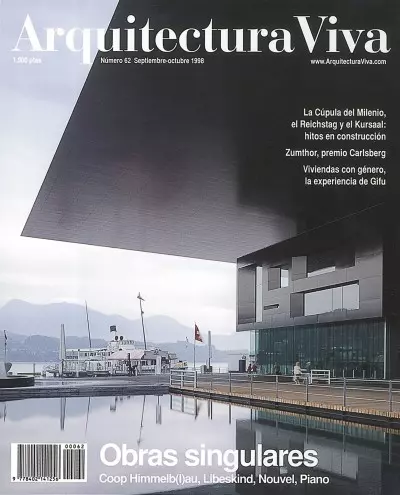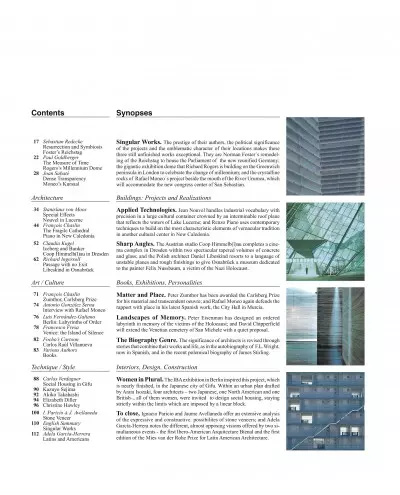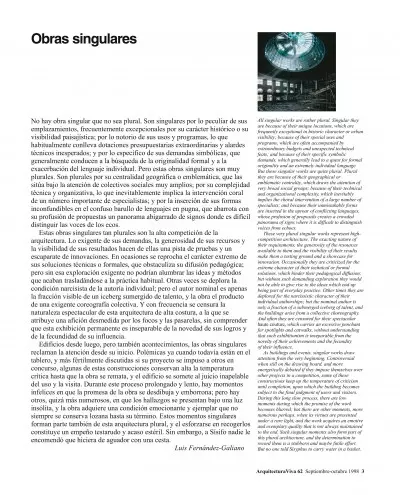Synopses
Singular Works.The prestige of their authors, the political significance of the projects and the emblematic character of their locations makes these three still unfinished works exceptional. They are Norman Foster´s remodeling of the Reichstag to house the Parliament of the new reunified Germany; the gigantic exhibition dome that Richard Rogers is building on the Greenwich peninsula in London to celebrate the change of millennium; and the crystalline rocks of Rafael Moneo´s project beside the mouth of the River Urumea, which will accommodate the new congress center of San Sebastian.
Contents
Sebastian Redecke
Resurrection and Symbiosis
Foster’s Reichstag
Paul Goldberger
The Measure of Time
Rogers’s Millennium Dome
Joan Sabaté
Dense Transparency
El Kursaal de Moneo
Buildings: Projects and Realizations
Applied Technologies. Jean Nouvel handles industrial vocabulary with precision in a large cultural container crowned by an interminable roof plane that reflects the waters of Lake Lucerne; and Renzo Piano uses contemporary techniques to build on the most characteristic elements of vernacular tradition in another cultural center in New Caledonia.
Architecture
Stanislaus von Moos
Special Effects
Nouvel in Lucerne
François Chaslin
The Fragile Cathedral
Piano in New Caledonia
Sharp Angles. The Austrian studio Coop Himmelb(l)au completes a cinema complex in Dresden within two spectacular tapered volumes of concrete and glass; and the Polish architect Daniel Libeskind resorts to a language of unstable planes and rough finishings to give Osnabrück a museum dedicated to the painter Félix Nussbaum, a victim of the Nazi Holocaust.
Claudia Kugel
Iceberg and Bunker
Coop Himmelb(l)au in Dresden
Richard Ingersoll
Passage with no Exit
Libeskind in Osnabrück
Books, Exhibitions, Personalities
Matter and Place. Peter Zumthor has been awarded the Carlsberg Prize for his material and transcendent oeuvre; and Rafael Moneo again defends the rapport with place in his latest Spanish work, the City Hall in Murcia.
Art / Culture
François Chaslin
Zumthor, Carlsberg Prize
Antonio González Serna
Interview with Rafael Moneo
Landscapes of Memory. Peter Eisenman has designed an ordered labyrinth in memory of the victims of the Holocaust; and David Chipperfield will extend the Venetian cemetery of San Michele with a quiet proposal. Luis Fernández-Galiano
Berlin: Labyrinths of Order
Francesco Fresa
Venice: the Island of SilenceThe Biography Genre. The significance of architects is revised through stories that combine their works and life, as in the autobiography of F.L.Wright, now in Spanish, and in the recent polemical biography of James Stirling.
Focho’s Cartoon
Carlos Raúl Villanueva
Various Authors
Books
Interiors, Design, Construction
Women in Plural. The IBA exhibition in Berlin inspired this project, which is nearly finished, in the Japanese city of Gifu. Within an urban plan drafted by Arata Isozaki, four architects – two Japanese, one North American and one British–, all of them women, were invited to design social housing, staying strictly within the limits which are imposed by a linear block.
Technique / Style
Carlos Verdaguer
Social Housing in Gifu
• Kazuyo Sejima
• Akiko Takahashi
• Elizabeth Diller
• Christine Hawley
To close, Ignacio Paricio and Jaume Avellaneda offer an extensive analysis of the expressive and constructive possibilites of stone veneers; and Adela García-Herrera notes the different, almost opposing visions offered by two simultaneous events - the first Ibero-American Arquitecture Bienal and the first edition of the Mies van der Rohe Prize for Latin American Architecture. I. Paricio y J. Avellaneda
Stone Veneer
English Summary
Singular Works
Adela García-Herrera
Latins and Americans
Luis Fernández-Galiano
Singular Works
All singular works are rather plural. Singular they are because of their unique locations, which are frequently exceptional in historic character or urban visibility; because of their special uses and programs, which are often accompanied by extraordinary budgets and unexpected technical feats; and because of their specific symbolic demands, which generally lead to a quest for formal originality and an extremely individual language. But these singular works are quite plural. Plural they are because of their geographical or emblematic centrality, which draws the attention of very broad social groups; because of their technical and organizational complexity, which inevitably implies the choral intervention of a large number of specialists; and because their unmistakable forms are inserted in the uproar of conflicting languages, whose profusion of proposals creates a crowded panorama of signs where it is difficult to distinguish voices from echoes.
These very plural singular works represent high-competition architecture. The exacting nature of their requirements, the generosity of the resources available to them and the visibility of their results make them a testing ground and a showcase for innovation. Occasionally they are criticized for the extreme character of their technical or formal solutions, which hinder their pedagogical diffusion; but without such demanding exploration they would not be able to give rise to the ideas which end up being part of everyday practice. Other times they are deplored for the narcissistic character of their individual authorships; but the nominal author is only a fraction of a submerged iceberg of talent, and the buildings arise from a collective choreography. And often they are censured for their spectacular haute couture, which carries an excessive penchant for spotlights and catwalks, without understanding that such exhibitionism is inseparable from the novelty of their achievements and the fecundity of their influence.
As buildings and events, singular works draw attention from the very beginning. Controversial when still on the drawing board, and more energetically debated if they impose themselves over other projects in a competition, some of these constructions keep up the temperature of criticism until completion, upon which the building becomes subject to the final judgment of users and visitors. During this long slow process, there are low moments during which the promise of the work becomes blurred; but there are other moments, more numerous perhaps, when its virtues are presented under a rare light, and the work acquires an emotive and exemplary quality that is not always maintained to the end. Such singular moments also form part of this plural architecture, and the determination to record them is a stubborn and maybe futile effort. But no one told Sisyphus to carry water in a basket.








